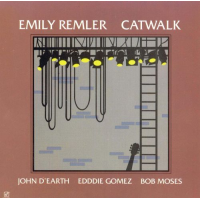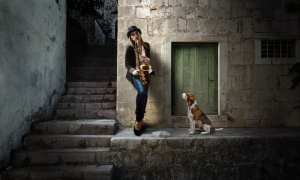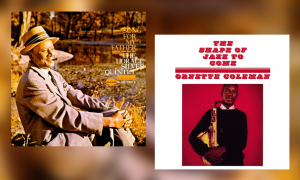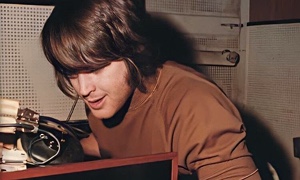Home » Jazz Articles » Building a Jazz Library » Guitar Gods & Goddesses: An Alternative Top Ten Albums
Guitar Gods & Goddesses: An Alternative Top Ten Albums

Courtesy Tomescu Stefan
No one is outside tradition. But it is boring when music becomes a set of rules and the aim is trying to sound like someone else. The original will always be better. Gustav Mahler said that ‘Tradition is the passing on of fire and not the adoration of ashes.’ I am not into the museum approach to music.
—Eivind Aarset
A rapidly growing number of players followed Christian in the late 1940s and 1950s, increasing exponentially with the rise of jazz-rock in the late 1960s. Since then, the guitar has become a jazz staple.
In order to spotlight a few less widely celebrated albums and musicians, this Alternative Top Ten has excluded all albums by Christian, Django Reinhardt, Wes Montgomery, Jim Hall, Grant Green, Pat Metheny, John Scofield and Bill Frisell, some of whose work would be essential in any representative library. Among the many other players worthy of attention are Barney Kessel, Herb Ellis, Jimmy Raney, Kenny Burrell, Joe Pass, Larry Coryell, Charlie Hunter, Pat Martino, Allan Holdsworth, John Abercrombie and Terje Rypdal. They too have been excluded. Maybe next time.
The albums listed below—five star classics all of them—are by Johnny Smith, Mary Osborne, Lenny Breau, Sandy Bull, Amancio D'Silva, Phillip Tabane, James Blood Ulmer, Emily Remler, Sonny Sharrock and (pictured above) Eivind Aarset. Hopefully you will find a couple of titles that are new to you among them.
TEN GUITAR ALBUMS OF SURPASSING BEAUTY
 Johnny Smith Quintet
Johnny Smith QuintetJazz At NBC
Royal Roost, 1953
An eight-track compilation of four singles—A sides and B sides—recorded by Johnny Smith with tenor saxophonist Stan Getz in 1952, the 10" LP Jazz At NBC still ranks as one of the most exquisitely beautiful jazz albums of all time. Just as Wes Montgomery's virtuosic use of parallel octaves sent other guitarists into a tailspin in the late 1950s, so did Smith's lush chordal melody playing earlier in the decade. Radio audiences went weak at the knees, making one of the singles included here, "Moonlight In Vermont," a massive hit on the US East Coast in 1952, bigger even than the Gerry Mulligan Quartet's "Bernie's Tune" (Pacific Jazz) on the West Coast the same year. Rendering melodies with chords rather than single notes—a technique Smith perfected after watching Hammond B3 players holding down one key while transitioning to a new chord—required not only an encyclopaedic knowledge of chord voicings but also a blinding technique. Smith had both: listen to the warp-speed delivery of his boppish original "Jaguar" here and gasp. Smith spent most of the 1950s in Manhattan as a studio musician with the NBC network, but in 1958, following the passing of his wife, he left New York to bring up his daughter in Colorado Springs, where he later opened a guitar store (and acquired a nice little nest egg as composer of "Walk, Don't Run," an international hit for beat combo The Ventures in 1960). Jazz At NBC has been reissued with additional tracks as Moonlight In Vermont.
 Mary Osborne
Mary Osborne A Girl And Her Guitar
Warwick, 1960
Practically forgotten in 2021, Mary Osborne was a child prodigy who had her own radio show in her hometown in North Dakota when she was 12 years old, singing country songs and accompanying herself on the guitar. Around 1937, when she would have been 16, she heard Charlie Christian play in a local club. Osborne sat in with the band and decided to become a jazz musician on the spot. Around 1940, she moved to New York City, where in mid decade she was a regular on 52nd Street, accompanying and recording with Street mainstays such as pianists Mary Lou Williams and Art Tatum, tenor saxophonist Coleman Hawkins and singer Billie Holiday, who can be seen enjoying Osborne's mercurial lyricism in the YouTube clip below. On the lovely A Girl And Her Guitar, Osborne leads rhythm guitarist Danny Barker, pianist Tommy Flanagan, bassist Tommy Potter and drummer Jo Jones on ten standards including Harry Barris' "I Surrender Dear," Duke Ellington's "Sophisticated Lady," Johnny Green's "Body And Soul" and Jack Strachey's "These Foolish Things" plus her own "Mary's Goodbye Blues." Divine.
 Sandy Bull
Sandy Bull Inventions
Vanguard, 1965
Sandy Bull's second duet album with drummer Billy Higgins has him playing acoustic and electric guitars, banjo, oud and electric bass through a multi-tracked melange which takes in jazz, Luiz Bonfa's "Manha Da Carnaval," two reconstructed Bach gavottes and a swamp-rock instrumental version of Chuck Berry's "Memphis Tennessee." The album opens with "Blend II," a 24-minute prairie-wide original which is the second chapter of a trilogy which begins with "Blend," which takes up the first side of Fantasias (Vanguard, 1963) and ends with "Electric Blend," which takes up the second side of E Pluribus Unum (Vanguard, 1969). There would likely have been more chapters but, sadly, in the early 1970s Bull descended into cocaine and heroin-induced stasis, from which he recovered but following which he went into semi-retirement. Totally uncategorisable and totally wonderful and as much jazz as they are anything else, Inventions and the two albums which bookend it are magic moments in twentieth century music.
 Lenny Breau
Lenny Breau The Velvet Touch Of Lenny Breau—Live!
RCA Victor, 1969
The aforementioned Johnny Smith crops up again on this album. Not on guitar but as the author of the sleeve note, the musical equivalent of Shakespeare penning an endorsement of an unknown playwright. Smith's admiration for Lenny Breau was widely shared among American guitarists—Chet Atkins, for instance, was instrumental in persuading RCA Victor to sign him. With Smith and Atkins in his corner, you might imagine the sky was the limit for Breau, whose virtuosic finger-picked style, derived from his years in the country music band led by his parents, was accompanied by a lyrical touch on a par with that of pianist Bill Evans. But, inexplicably, Breau stayed strictly niche during his lifetime (he lived fast and died young, aged 43 years) and has remained so. The phenomenal The Velvet Touch Of Lenny Breau—Live! was recorded over three nights at Shelley's Manne-Hole in Hollywood. Breau is accompanied by bassist Ronnie Halldorson and drummer Reg Kelln on a selection of originals and covers (including a stunning, electronica-anticipating performance of Joe Zawinul's "Mercy, Mercy, Mercy.") The originals include "Indian Reflections For Ravi," Breau's sitar-evoking tribute to Ravi Shankar. Which segues us nicely into....
 Amancio D'Silva
Amancio D'SilvaIntegration
EMI Lansdown, 1969
Fascination with Indian music in the late 1960s was probably even more pronounced in Britain than it was in the US, because of the two countries' colonial and post-colonial connections. Earlier in the decade, London-based Indian violinist and composer John Mayer's band Indo-Jazz Fusions (featuring alto saxophonist Joe Harriott) planted the seeds of the hybrid music which John McLaughlin developed ten years later with violinist L Shankar and Shakti. Integration, the debut album by Goa-born guitarist Amancio D'Silva, drew even more direct inspiration from Mayer and Harriott's experiments. D'Silva completes a quintet drawn from trumpeter and flugelhornist Ian Carr and tenor and soprano saxophonist Don Rendell's band—Carr, Rendell, bassist Dave Green and drummer Trevor Tomkins. The album was recorded live in the studio and the sense of in-the-moment shared discovery is palpable. Another notable D'Silva album is Konkan Dance (Vocalion, recorded 1974, released 2006), made with a septet including Rendell, pianist Stan Tracey and sitar player Clem Alford. Konkan Dance's "A Street In Bombay" is covered on London-based percussionist Sarathy Korwar's excellent My East Is Your West (Gearbox, 2018).
 Phillip Tabane
Phillip Tabane The Indigenous Afro-Jazz Sounds Of Phillip Tabane And His Malombo Jazzman
Atlantic City, 1969
Most of the South African musicians who emerged in the 1960s playing what became known as "township jazz" fused gritty American hard bop with rhythmically urgent Zulu-originated styles such as kwela and mbaqanga. Phillip Tabane's Malombo—in the early incarnation heard on this album a duo with percussionist Mabi Thobejani—championed a spacier, more nuanced blend which drew on traditional Sotho ritual music from the north of the country. The band was a kind of black South African equivalent of Jimmy Guiffre's chamber jazz groups—although in Malombo's recordings, pastoral folk-derived tunes tend to build into fierce workouts splattered with minatory guitar chords. Although the band spent some time in the US in the 1970s—making a well received appearance at the Newport Jazz Festival in 1977—Tabane was not interested in an international career, preferring to remain a community-based musician in South Africa and do what he could to fight the apartheid regime. An admirer of Miles Davis' music, he once said, "He plays for money. I play for the spirit." Tabane continued to lead iterations of Malombo until he passed in Pretoria in 2018.
 James Blood Ulmer
James Blood UlmerOdyssey
Columbia, 1983
Adjust your headphones, please, before playing this high-decibel, high-impact, genre-bending album. South Carolina-born James Blood Ulmer started out in soul-jazz groups before moving to New York City in 1971 and joining the loose-knit community of avant-jazz musicians then known as The New Thing. He recorded with bands led by drummer Rashied Ali, tenor saxophonist Joe Henderson, organist Larry Young and alto saxophonist Ornette Coleman before ending the decade as a member of the septet which made one of the all-time under-the-radar jazz masterpieces, alto saxophonist Arthur Blythe's Lenox Avenue Breakdown (Columbia, 1979). That album led to a three album deal with Columbia, the third and best of which is the brilliantly self-produced Odyssey. Ulmer fronts a shamanistic power trio completed by violinist Charles Burnham and drummer Warren Benbow, which conjures the spirits of Albert Ayler, Jimi Hendrix, Robert Johnson and Sister Rosetta Tharpe to produce an avant-gutbucket blend of jazz, blues, gospel, rock and funk. Among the tracks is a reprise of "Are You Glad To Be In America?," the title track of Ulmer's breakthrough album for Britain's Rough Trade label in 1980 and heard here in a far superior version.
 Emily Remler
Emily RemlerCatwalk
Concord, 1985
Like the aforementioned Mary Osborne, Emily Remler is near enough forgotten in 2021. She debuted in 1981 with Firefly (Concord)—an aptly titled album, for Remler burned brightly and then passed young, aged just 32 years, from a heart attack which was almost certainly triggered by heroin and/or dilaudid. Originally foursquare in the lineage begun by Charlie Christian and developed by Wes Montgomery, by the time Remler recorded Catwalk, she was defining her own style. The album was the first to be built entirely around her own pieces, some of them flavoured with Brazilian, Caribbean, Indian or African rhythms, and was the second album on which she led a cracking quartet completed by trumpeter John D'Earth, bassist Eddie Gomez and drummer Bob Moses. The band swings like crazy and the disc is killer. As Remler said to People magazine in 1982, "I may look like a nice Jewish girl from New Jersey, but inside I'm a 50-year-old, heavyset black man with a big thumb, like Wes Montgomery."
 Sonny Sharrock
Sonny SharrockAsk The Ages
Axiom, 1991
Sonny Sharrock went way back with tenor saxophonist Pharoah Sanders, who is the horn player here. Equally at home in jazz and funk settings, Sharrock was one of the musicians who helped create the delicious, splintered beauty of Sanders' spiritual-jazz manifesto, Tauhid (Impulse!, 1967). So it is fitting that co-producer and Axiom label founder Bill Laswell reunited the pair on what proved to be Sharrock's final album, recorded with a quartet which is completed by acoustic bassist Charnett Moffett and drummer Elvin Jones. In the twenty-four years since their first meeting, Sharrock and Sanders had both perfected their distinctive blends of abrasion and lyricism and Ask The Ages is perhaps Sharrock's most satisfying own-name album, combining outer-limits experimentalism with Laswell's cutting-edge production values. In a close-run race, one of the standout tracks is the Sanders tribute, "Little Rock."
 Eivind Aarset
Eivind Aarset Dream Logic
ECM, 2012
In an interview with All About Jazz in 2020, Britain's Rob Luft picked this duo collaboration between Norwegian guitarist Eivind Aarset and electronicist Jan Bang as one of his six all-time favourite albums. "It's an album I put on when I'm travelling," said Luft, "when I'm looking out of a train window, when I want to sleep at night. It's an album that really sounds like dreams. It's wonderful how it floats for forty-five, fifty minutes and teleports you to another place. The production is impeccable and the sound is so glistening." Which pretty much nails it. (Luft's own album Life Is The Dancer, released on Edition in 2020, would be the next entry if this list was turned up to An Alternative Top Eleven Albums). Among other notable Aarset / Bang outings is trumpeter Jon Hassell's Last Night The Moon Came Dropping Its Clothes In The Street (ECM, 2009). For something rather different, check Aarset and Bang on reggae masters drummer Sly Dunbar and bassist Robbie Shakespeare 's Nordub (OKeh, 2018).
Tags
PREVIOUS / NEXT
Support All About Jazz
 All About Jazz has been a pillar of jazz since 1995, championing it as an art form and, more importantly, supporting the musicians who make it. Our enduring commitment has made "AAJ" one of the most culturally important websites of its kind, read by hundreds of thousands of fans, musicians and industry figures every month.
All About Jazz has been a pillar of jazz since 1995, championing it as an art form and, more importantly, supporting the musicians who make it. Our enduring commitment has made "AAJ" one of the most culturally important websites of its kind, read by hundreds of thousands of fans, musicians and industry figures every month.























